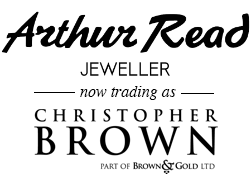Guide to Garnet
- 18 Nov 2019
- Daniel Read
It's a very under-rated gemstone, but in fact garnet offers lots of potential. When most people think of it, they automatically see red, or maybe a brownish or purplish red. While this may be one of the more commonly seen tones, it is by no means the only one as garnets come in a very wide range of colours, each with its own name and (unlike some other gems, where colour can change, but everything else remains the same) each with its own properties, which make it fairly easy to differentiate the different types.

THE SCIENCE BIT
Rather than being a single gem, garnets are a family of gems related by chemical make-up, all being similar, but differing slightly in exactly which chemicals are present. Put simply, there are two 'sets' of garnets, and within each set there is a fluid movement between the different members. One will gradually change into the next, as one specific element replaces another within the structure. This replacement leads to changes in the refractive index, specific gravity and, most visually, the colour of the stone.
The commonly regarded garnet is the red one, which really lies somewhere between two different forms. Pyrope garnet is the red to red brown form, which often combines with the purple-red Almandine garnet, which is chemically similar. This combination provides possibly the most readily available garnet, and has been used in jewellery for centuries.
Within the same strand of garnets lies another variety, this providing a more orange colour spessartine garnet. These three form a series often referred to as the pyralspite series which all run into each other, and it's rare to find one that is a chemically pure variety.

VERSATILITY
The alternative series of garnets has its own name, the ugrandite series, which also has three main varieties. Uvarovite garnet is a beautiful emerald- green colour, but unfortunately it doesn't form in gem-quality or gem-size crystals very often, and on the few occasions that it may have, it would probably have been an expensive stone. Luckily there are alternatives. Grossular garnet can provide a selection of greens, yellows and browns, and if the chemical make-up is altered slightly more, we even reach the yellow-browns, browns and blacks of andradite. These last two can, and do, Occur in high clarity gem-quality materials, and, in the grand scheme of commercial stones, are a reasonably priced option
Think that's it for garnets? Think again! There are many other varieties in the family. Looking for a more purple-red to rose-red colour? Then perhaps rhodolite garnet would fit the bill? Or maybe the cinnamon colours of hessonite, with its unique treacle-like internal appearance? Yellow or orange, imperial topaz-like? Then the variety of andradite known as topazolite may be just what's needed. Even totally opaque garnets can be easily found, bearing the name melanite - these were frequently used in mourning jewellery.
At the other end of the scale, you can even get leuco garnets, that are totally transparent and colourless - but they're not commonly seen. Colourless garnets are regularly synthesised as gallium gadolinium garnet and yttrium aluminium garnet respectively, and these were used as diamond simulants. Still unsure? Well garnets can also, if sufficient parallel, needle-like inclusions are present, show a four or six-rayed star, depending upon how they're cut. Cabochon forms are best for this-they allow the star to shine!

While garnets are the more affordable Christmassy-coloured stones, they can themselves be expensive, especially if you're looking for certain shades of green. Tsavorite garnet is a relatively new stone, having only been found in the Tsavo region of Kenya in the 1970's. This has a beautiful true green colour, and a lustre comparable to that of any sapphire.
At the top end of the scale lies the most valuable and desirable of all garnets, the demantoid garnet, named for its very high lustre (derived from 'adamantine', the lustre of a diamond). With a green body colour its unique inclusions take the form of radiating fibres affectionately known as 'horsetails'. This stone holds a special place in history as a favourite of jewellers such as Fabergė. The first sources of demantoid were in the Russian Ural mountains, and were incorporated into jewellery for the Tsars.
So.. garnets are not simply the red stones that were common in medieval times, and are often seen in antique jewellery. They are a timeless and modern stone, versatile in colours and properties, and able to present a combination of lustre and brilliance that allows them to compete against any other gem!
Taken from The Guild of Jeweller's Coloured Stones Guide Vol.1



Comments
Muchas gracias. ?Como puedo iniciar sesion?
NuAkjHFZ
JObWutiKcoG
sHjnLSux
XyWgkMnrGqp